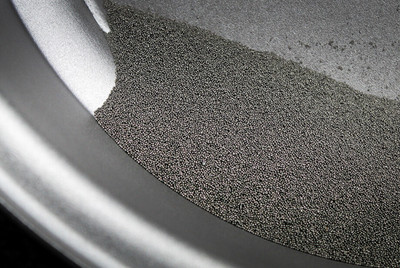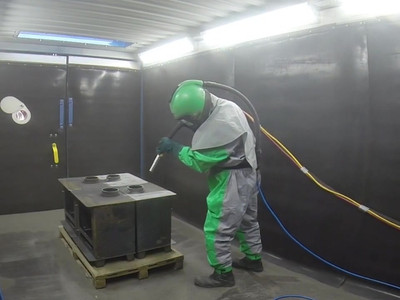23rd Oct 2024
Finding the right abrasive media is crucial for achieving the desired results. Whether you’re cleaning, polishing, or removing coatings, the choice of media can significantly impact the efficiency and effectiveness of the process. One option that’s gaining popularity, especially for its eco-friendliness and versatility, is walnut shells. But what makes walnut shells stand out as an abrasive media, and where are they best used? Let’s explore the key applications and advantages of using walnut shells in abrasive blasting.
What are walnut shells, and why are they used as abrasive media?
Walnut shells are a natural, biodegradable product derived from crushed walnut kernels. They are surprisingly effective when used as an abrasive media, thanks to their medium hardness and angular shape, which allows them to gently yet efficiently remove coatings, dirt, and contaminants from surfaces. Unlike harsher media, walnut shells offer a softer touch, making them ideal for cleaning fine materials delicately.
There are two types of walnut shell that are commonly used in abrasive blasting: crushed black or English walnut shells. Black walnut shell is thicker and harder, so in larger grade sizes, it will appear rounder than English walnut. You will see less pitting and scarring when blasting wood when using black walnut shell because it is rounder. English walnut shell is more lightweight, has a thinner shell, and contains a lot more pith or membrane.
How do walnut shells compare to other abrasive media in blasting?
Walnut shells occupy a unique space in the abrasive media landscape. They are softer than glass beads or steel grit, making them suitable for more gentle cleaning tasks. While harder media might be better suited for heavy-duty applications like rust removal from steel, walnut shells are excellent for situations where preserving the integrity of the material is critical. For instance, in industries like aerospace or automotive restoration, the non-abrasive nature of walnut shells ensures that surfaces are cleaned without any etching or wear.
What are the main applications of walnut shells in blasting?
Walnut shells are used in a variety of industries for a range of applications. Some of the most common include:
- Aerospace maintenance: Walnut shells are perfect for cleaning turbine blades and other engine parts without damaging the metal. Their gentle nature ensures that the parts maintain their original specifications while being cleaned.
- Automotive restoration: In car restoration, walnut shells are frequently used to remove paint, carbon deposits, and grime from engines and body parts without affecting the underlying metal or glass.
What are the advantages of using walnut shells as an abrasive media?
There are several reasons why walnut shells are becoming a preferred choice in blasting.
- As a natural product, walnut shells are biodegradable and safe to dispose of, making them an environmentally friendly option.
- Their relatively soft structure allows for effective cleaning of delicate materials, such as metals, plastics, and wood, without causing damage.
- Walnut shells can be reused multiple times before breaking down, which adds to their cost-effectiveness.
- Walnut shells generate less dust than some other blasting media, making for a cleaner and safer work environment.
Are there any limitations to using walnut shells in blasting?
While walnut shells have many advantages, they are not suitable for every grit blasting application. Their softer nature makes them less effective for extremely tough jobs, such as heavy-duty rust removal or cleaning hardened steel. For projects that require aggressive abrasion, media like steel grit or aluminium oxide may be a better choice.
How do walnut shells contribute to environmentally friendly blasting?
With growing concerns about environmental sustainability, walnut shells offer a green solution to traditional abrasive blasting. They are a renewable resource, fully biodegradable, and do not produce harmful by-products. This makes them an attractive choice for companies looking to reduce their environmental footprint without compromising the quality of their work.
What industries or projects benefit most from walnut shell abrasive media?
Walnut shells are particularly useful in industries that prioritise surface preservation and cleanliness. Aviation, marine, and automotive sectors are key examples, as these industries require precision cleaning without damaging underlying structures. Additionally, walnut shells are frequently used in restoration projects, where the goal is to clean or restore surfaces without altering or degrading them.
How does walnut shell work in practice?
In practice, walnut shell blasting involves using blasting equipment to shoot walnut shell particles at a surface under controlled pressure. The shells’ angular particles gently remove unwanted coatings, dirt, or contaminants without causing damage to the surface itself. This process can be done with standard blasting equipment, making it an easy switch for businesses looking to adopt a more eco-friendly abrasive media.
Conclusion
Walnut shells offer a versatile, eco-friendly option for blasting, ideal for applications that require gentle but effective cleaning. Their non-toxic, biodegradable nature and reusable properties make them a sustainable choice for industries that prioritise surface preservation and environmental responsibility. While they may not be suited for the toughest jobs, walnut shells provide an excellent solution for many blasting needs, especially in aerospace, automotive restoration, and delicate surface cleaning. By understanding the benefits and limitations of walnut shells as an abrasive media, you can make informed decisions about which blasting material best suits your project’s needs.
Airblast offer Walnut Shells as an abrasive media, available to purchase here. To see our full range of abrasive media, click here. Or, if you are unsure of what abrasive media is best suited for you, take a look at our brochure here, or ring a member of our team on 01778 560650 who can assist you in your decision.




